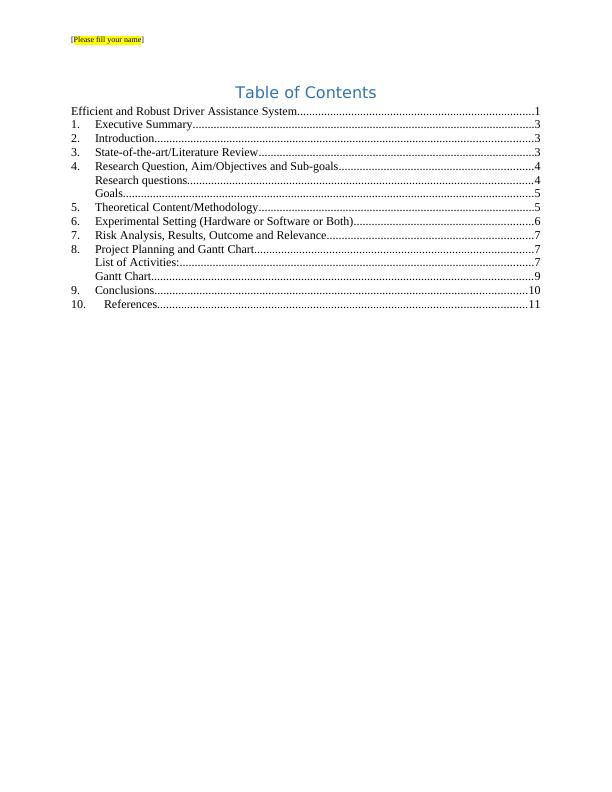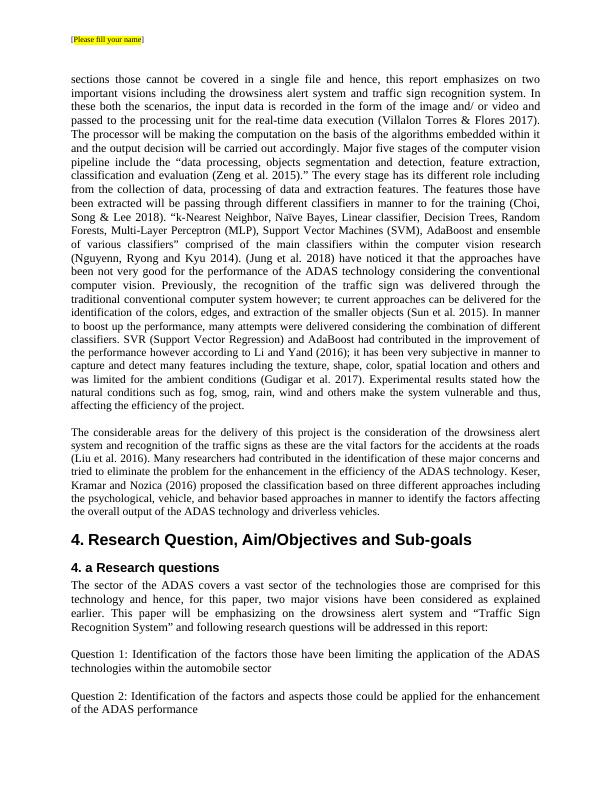Efficient and Robust Driver Assistance System
Robust and Efficient Driver Assistance System for road safety
11 Pages3457 Words470 Views
Added on 2023-06-13
About This Document
This report proposes a methodology to improve the efficiency and robustness of ADAS technology for driver assistance systems. It covers the challenges and solutions for driver drowsiness and traffic sign recognition, utilizing distributed representation learning techniques. The report aims to enhance the safety of drivers on the road and focuses on long-term administration and road safety for automobile majors, humanity, and policy makers.
Efficient and Robust Driver Assistance System
Robust and Efficient Driver Assistance System for road safety
Added on 2023-06-13
ShareRelated Documents
[Please fill your name]
Efficient and Robust Driver Assistance System
By ‘[Please fill your name]
Affiliation (MSc Profile or Track) & Study no.
Efficient and Robust Driver Assistance System
By ‘[Please fill your name]
Affiliation (MSc Profile or Track) & Study no.

[Please fill your name]
Table of Contents
Efficient and Robust Driver Assistance System...............................................................................1
1. Executive Summary..................................................................................................................3
2. Introduction..............................................................................................................................3
3. State-of-the-art/Literature Review............................................................................................3
4. Research Question, Aim/Objectives and Sub-goals.................................................................4
Research questions...................................................................................................................4
Goals.........................................................................................................................................5
5. Theoretical Content/Methodology............................................................................................5
6. Experimental Setting (Hardware or Software or Both)............................................................6
7. Risk Analysis, Results, Outcome and Relevance.....................................................................7
8. Project Planning and Gantt Chart.............................................................................................7
List of Activities:......................................................................................................................7
Gantt Chart...............................................................................................................................9
9. Conclusions............................................................................................................................10
10. References...........................................................................................................................11
Table of Contents
Efficient and Robust Driver Assistance System...............................................................................1
1. Executive Summary..................................................................................................................3
2. Introduction..............................................................................................................................3
3. State-of-the-art/Literature Review............................................................................................3
4. Research Question, Aim/Objectives and Sub-goals.................................................................4
Research questions...................................................................................................................4
Goals.........................................................................................................................................5
5. Theoretical Content/Methodology............................................................................................5
6. Experimental Setting (Hardware or Software or Both)............................................................6
7. Risk Analysis, Results, Outcome and Relevance.....................................................................7
8. Project Planning and Gantt Chart.............................................................................................7
List of Activities:......................................................................................................................7
Gantt Chart...............................................................................................................................9
9. Conclusions............................................................................................................................10
10. References...........................................................................................................................11

[Please fill your name]
1. Executive Summary
In Automobile Industry, ADAS (Advance Driver Assistance Systems) has been becoming its
integral part because of the advancement in the interest of the consumers and the government
regulations in the aspects related to the safety of the road. There are many beneficial aspects of
the ADAS that includes monitoring the outer environment, generating warnings for the instances
of danger, providing information related to the traffic signals and allowing them to be ahead of
the time. Other benefits are applying brakes for the scenarios where there is the possibility of the
collisions, monitoring the behavior of the drivers while driving including aggressiveness, panic,
sleepy, and many more. There are many drawbacks in the ADAS system resulting in the
decrement of the efficiency and robustness of the system that includes fading of the traffic
signals, change in the view point of the camera, natural conditions, and image blurring. The aim
of this project is to mitigate these challenges through utilizing the “distributed representation
learning techniques” those can be utilized in making the system much efficient, robust, and
applicable in the real world scenarios.
The methodology proposed in this report is capable of improving the ADAS technologies in
manner to make the system much efficient, robust and thus, enhance the performance of the
technology. The scope of the project is to enhance the safety of the drivers on the road focusing
on the long-term administration and road safety for many of the automobile majors, humanity,
and policy makers.
2. Introduction
Artificial Intelligence (AI) has been contributing in the development of the life living of the
individuals through facilitating the automation in the real life and many applications of the AI in
the real world. More or less AI can be applicable in most of the sectors in the real world and so is
in the automobile sector that has been advanced with the technology and resulted in many
beneficial advancement. Most of the accident cases at the roads occur because of the negligence
of the drivers and ADAS is capable of predicting the scenarios and presenting solution for
eliminating these challenges through the real-time data collection and execution. Many
automated cars have been utilizing the LiDAR (Light Detection and Ranging), RADAR (Radio
Detection and Ranging), and IR (infrared) sensors, cameras, and Ultrasonic cameras. However,
the performance of the ADAS technology has not been much reliable until the date and this
report aims at highlighting o that perspective and proposing solutions those could be utilized for
eliminating the problems. It can be stated that the automobile industry’s les in the option of
presenting driverless cars with zero error and 100% efficiency. The objective of this project is to
eliminate the identified issues and propose effective solutions those could be applied for the
enhancement in the performance of the ADAS technology and make it more robust, efficient, and
accurate.
3. State-of-the-art/Literature Review
ADSAS can be represented as encapsulation of various systems comprised of IoT (Internet of
Things) and V2V (vehicle-to-vehicle) wireless communication systems, vision camera systems,
and sensor technologies (kale and Mahajan 2015). The ADAS system comprised of very vast
1. Executive Summary
In Automobile Industry, ADAS (Advance Driver Assistance Systems) has been becoming its
integral part because of the advancement in the interest of the consumers and the government
regulations in the aspects related to the safety of the road. There are many beneficial aspects of
the ADAS that includes monitoring the outer environment, generating warnings for the instances
of danger, providing information related to the traffic signals and allowing them to be ahead of
the time. Other benefits are applying brakes for the scenarios where there is the possibility of the
collisions, monitoring the behavior of the drivers while driving including aggressiveness, panic,
sleepy, and many more. There are many drawbacks in the ADAS system resulting in the
decrement of the efficiency and robustness of the system that includes fading of the traffic
signals, change in the view point of the camera, natural conditions, and image blurring. The aim
of this project is to mitigate these challenges through utilizing the “distributed representation
learning techniques” those can be utilized in making the system much efficient, robust, and
applicable in the real world scenarios.
The methodology proposed in this report is capable of improving the ADAS technologies in
manner to make the system much efficient, robust and thus, enhance the performance of the
technology. The scope of the project is to enhance the safety of the drivers on the road focusing
on the long-term administration and road safety for many of the automobile majors, humanity,
and policy makers.
2. Introduction
Artificial Intelligence (AI) has been contributing in the development of the life living of the
individuals through facilitating the automation in the real life and many applications of the AI in
the real world. More or less AI can be applicable in most of the sectors in the real world and so is
in the automobile sector that has been advanced with the technology and resulted in many
beneficial advancement. Most of the accident cases at the roads occur because of the negligence
of the drivers and ADAS is capable of predicting the scenarios and presenting solution for
eliminating these challenges through the real-time data collection and execution. Many
automated cars have been utilizing the LiDAR (Light Detection and Ranging), RADAR (Radio
Detection and Ranging), and IR (infrared) sensors, cameras, and Ultrasonic cameras. However,
the performance of the ADAS technology has not been much reliable until the date and this
report aims at highlighting o that perspective and proposing solutions those could be utilized for
eliminating the problems. It can be stated that the automobile industry’s les in the option of
presenting driverless cars with zero error and 100% efficiency. The objective of this project is to
eliminate the identified issues and propose effective solutions those could be applied for the
enhancement in the performance of the ADAS technology and make it more robust, efficient, and
accurate.
3. State-of-the-art/Literature Review
ADSAS can be represented as encapsulation of various systems comprised of IoT (Internet of
Things) and V2V (vehicle-to-vehicle) wireless communication systems, vision camera systems,
and sensor technologies (kale and Mahajan 2015). The ADAS system comprised of very vast

[Please fill your name]
sections those cannot be covered in a single file and hence, this report emphasizes on two
important visions including the drowsiness alert system and traffic sign recognition system. In
these both the scenarios, the input data is recorded in the form of the image and/ or video and
passed to the processing unit for the real-time data execution (Villalon Torres & Flores 2017).
The processor will be making the computation on the basis of the algorithms embedded within it
and the output decision will be carried out accordingly. Major five stages of the computer vision
pipeline include the “data processing, objects segmentation and detection, feature extraction,
classification and evaluation (Zeng et al. 2015).” The every stage has its different role including
from the collection of data, processing of data and extraction features. The features those have
been extracted will be passing through different classifiers in manner to for the training (Choi,
Song & Lee 2018). “k-Nearest Neighbor, Naïve Bayes, Linear classifier, Decision Trees, Random
Forests, Multi-Layer Perceptron (MLP), Support Vector Machines (SVM), AdaBoost and ensemble
of various classifiers” comprised of the main classifiers within the computer vision research
(Nguyenn, Ryong and Kyu 2014). (Jung et al. 2018) have noticed it that the approaches have
been not very good for the performance of the ADAS technology considering the conventional
computer vision. Previously, the recognition of the traffic sign was delivered through the
traditional conventional computer system however; te current approaches can be delivered for the
identification of the colors, edges, and extraction of the smaller objects (Sun et al. 2015). In manner
to boost up the performance, many attempts were delivered considering the combination of different
classifiers. SVR (Support Vector Regression) and AdaBoost had contributed in the improvement of
the performance however according to Li and Yand (2016); it has been very subjective in manner to
capture and detect many features including the texture, shape, color, spatial location and others and
was limited for the ambient conditions (Gudigar et al. 2017). Experimental results stated how the
natural conditions such as fog, smog, rain, wind and others make the system vulnerable and thus,
affecting the efficiency of the project.
The considerable areas for the delivery of this project is the consideration of the drowsiness alert
system and recognition of the traffic signs as these are the vital factors for the accidents at the roads
(Liu et al. 2016). Many researchers had contributed in the identification of these major concerns and
tried to eliminate the problem for the enhancement in the efficiency of the ADAS technology. Keser,
Kramar and Nozica (2016) proposed the classification based on three different approaches including
the psychological, vehicle, and behavior based approaches in manner to identify the factors affecting
the overall output of the ADAS technology and driverless vehicles.
4. Research Question, Aim/Objectives and Sub-goals
4. a Research questions
The sector of the ADAS covers a vast sector of the technologies those are comprised for this
technology and hence, for this paper, two major visions have been considered as explained
earlier. This paper will be emphasizing on the drowsiness alert system and “Traffic Sign
Recognition System” and following research questions will be addressed in this report:
Question 1: Identification of the factors those have been limiting the application of the ADAS
technologies within the automobile sector
Question 2: Identification of the factors and aspects those could be applied for the enhancement
of the ADAS performance
sections those cannot be covered in a single file and hence, this report emphasizes on two
important visions including the drowsiness alert system and traffic sign recognition system. In
these both the scenarios, the input data is recorded in the form of the image and/ or video and
passed to the processing unit for the real-time data execution (Villalon Torres & Flores 2017).
The processor will be making the computation on the basis of the algorithms embedded within it
and the output decision will be carried out accordingly. Major five stages of the computer vision
pipeline include the “data processing, objects segmentation and detection, feature extraction,
classification and evaluation (Zeng et al. 2015).” The every stage has its different role including
from the collection of data, processing of data and extraction features. The features those have
been extracted will be passing through different classifiers in manner to for the training (Choi,
Song & Lee 2018). “k-Nearest Neighbor, Naïve Bayes, Linear classifier, Decision Trees, Random
Forests, Multi-Layer Perceptron (MLP), Support Vector Machines (SVM), AdaBoost and ensemble
of various classifiers” comprised of the main classifiers within the computer vision research
(Nguyenn, Ryong and Kyu 2014). (Jung et al. 2018) have noticed it that the approaches have
been not very good for the performance of the ADAS technology considering the conventional
computer vision. Previously, the recognition of the traffic sign was delivered through the
traditional conventional computer system however; te current approaches can be delivered for the
identification of the colors, edges, and extraction of the smaller objects (Sun et al. 2015). In manner
to boost up the performance, many attempts were delivered considering the combination of different
classifiers. SVR (Support Vector Regression) and AdaBoost had contributed in the improvement of
the performance however according to Li and Yand (2016); it has been very subjective in manner to
capture and detect many features including the texture, shape, color, spatial location and others and
was limited for the ambient conditions (Gudigar et al. 2017). Experimental results stated how the
natural conditions such as fog, smog, rain, wind and others make the system vulnerable and thus,
affecting the efficiency of the project.
The considerable areas for the delivery of this project is the consideration of the drowsiness alert
system and recognition of the traffic signs as these are the vital factors for the accidents at the roads
(Liu et al. 2016). Many researchers had contributed in the identification of these major concerns and
tried to eliminate the problem for the enhancement in the efficiency of the ADAS technology. Keser,
Kramar and Nozica (2016) proposed the classification based on three different approaches including
the psychological, vehicle, and behavior based approaches in manner to identify the factors affecting
the overall output of the ADAS technology and driverless vehicles.
4. Research Question, Aim/Objectives and Sub-goals
4. a Research questions
The sector of the ADAS covers a vast sector of the technologies those are comprised for this
technology and hence, for this paper, two major visions have been considered as explained
earlier. This paper will be emphasizing on the drowsiness alert system and “Traffic Sign
Recognition System” and following research questions will be addressed in this report:
Question 1: Identification of the factors those have been limiting the application of the ADAS
technologies within the automobile sector
Question 2: Identification of the factors and aspects those could be applied for the enhancement
of the ADAS performance

End of preview
Want to access all the pages? Upload your documents or become a member.
Related Documents
Professional and Ethical Practice Report 2022lg...
|12
|1048
|26
Information Technology - Sample Assignmentlg...
|8
|1831
|206
IoT for Restricting Road Accidentslg...
|10
|1838
|310
Intelligent Transportation System: Applications, Benefits, and Solutionslg...
|11
|3401
|26
The Effect of Self-Driving Trucks on Truckinglg...
|6
|1903
|20
Internet of Things: The Protocols and Applicationslg...
|12
|3121
|267
